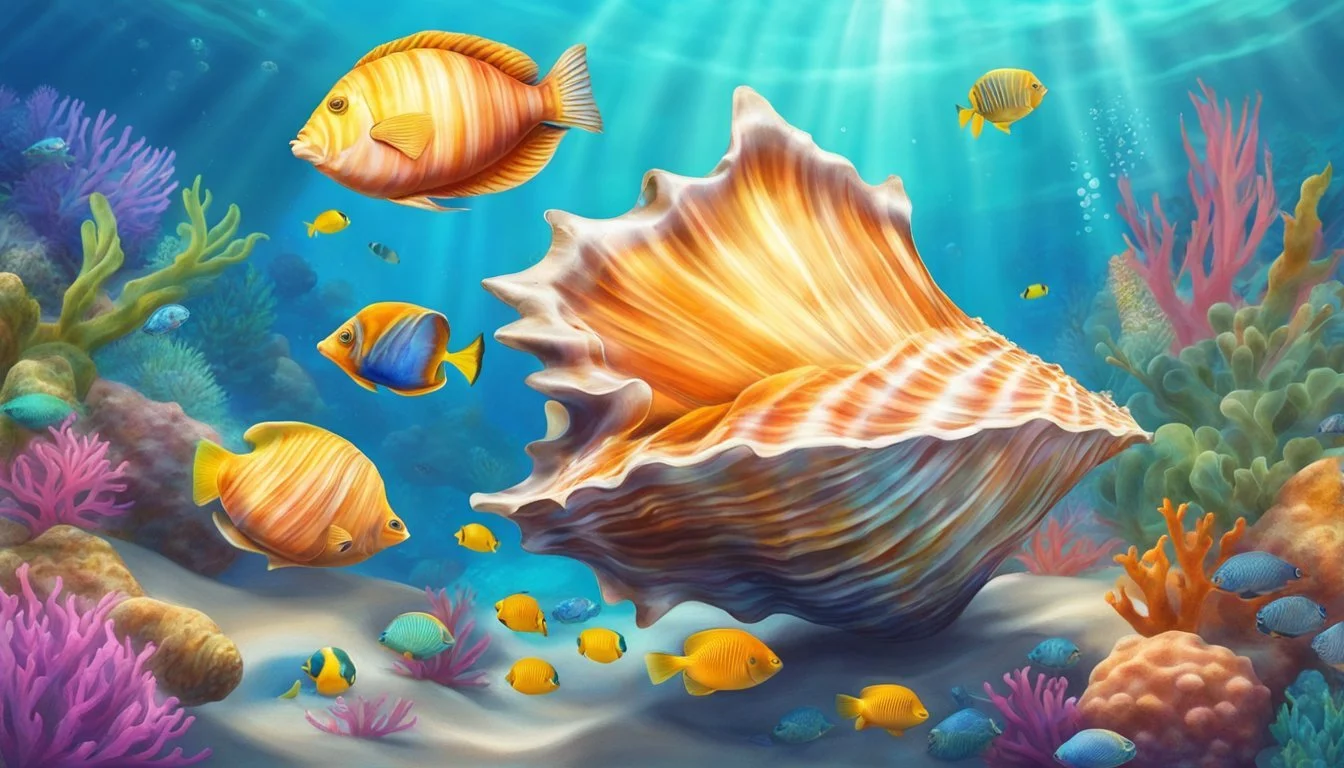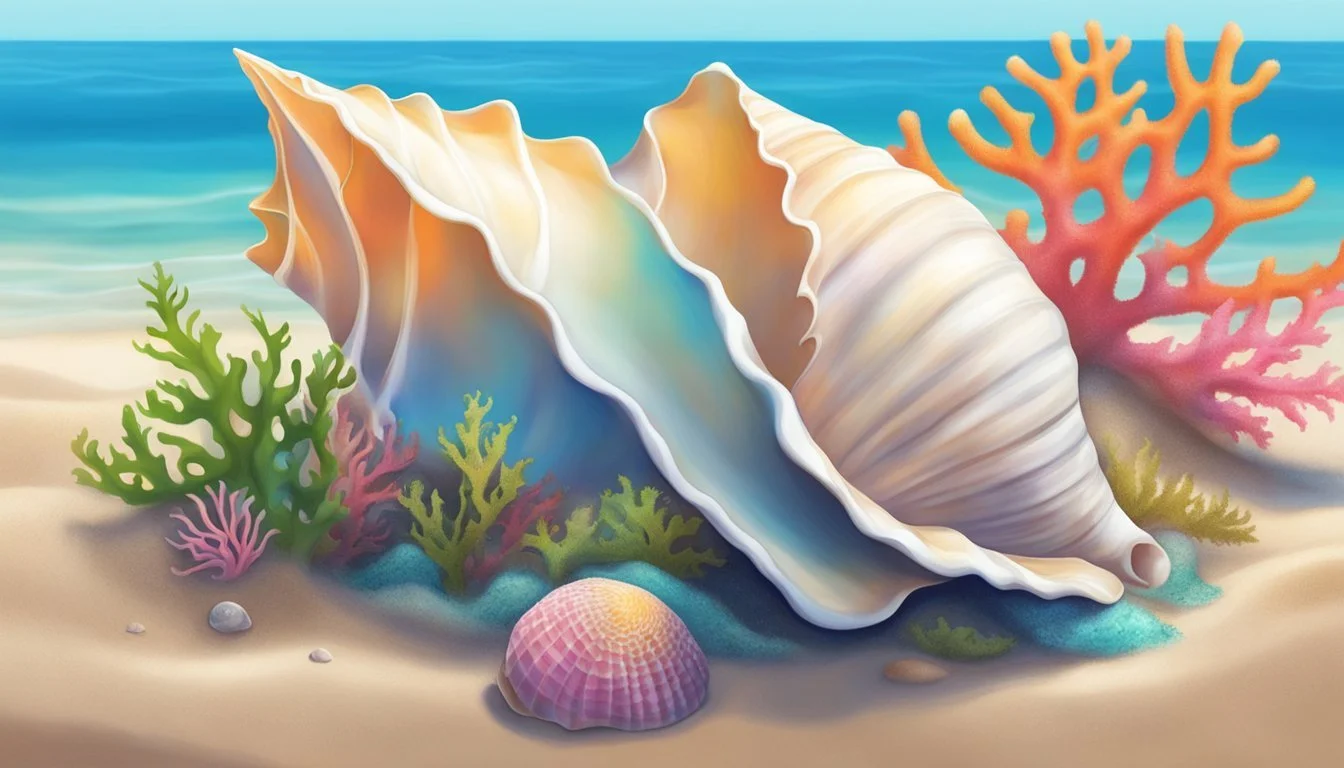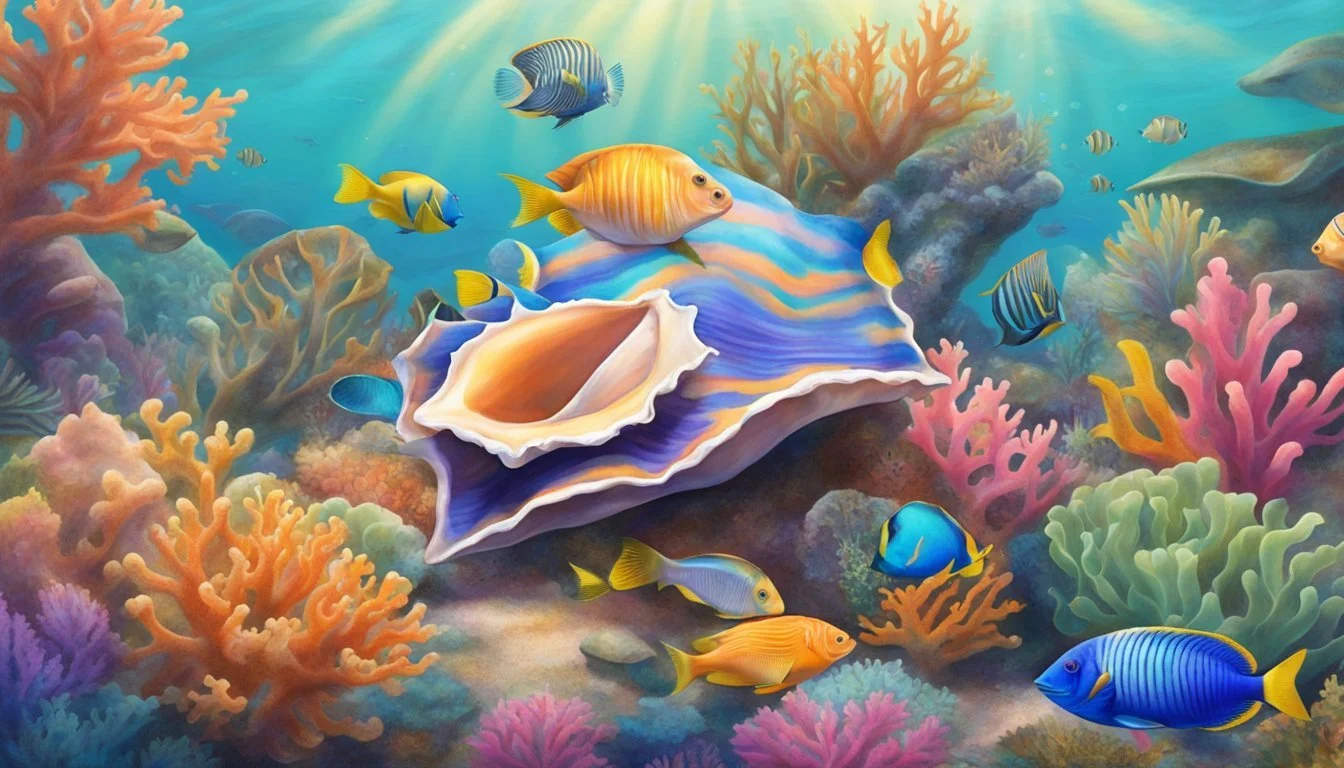Conch The Caribbean Sea Snail's Culinary and Cultural Impact
The conch, a type of large sea snail found in the warm marine waters of the Caribbean Sea and adjacent regions, has long held a place of importance in local culture, cuisine, and economies. To identify a conch, one would typically look for its robust spiral shell, which can grow quite large, and its fleshy body, stretching up to 12 inches in length. Queen conch, scientifically known as Aliger gigas, is the most recognized species and has been a staple in Caribbean societies, with conch shells being employed in art, music, and as a food source.
These marine gastropods are not just crucial to the culture but also to the ecosystem. Conchs are benthic herbivores, primarily grazing on algae, seagrass detritus, and other organic materials found on the ocean floor, contributing to the health of coral reefs. Known for their longevity, they can live for up to 30 years, growing slowly and maturing over time. This life history makes them vulnerable to overfishing, which has led to a significant reduction in their numbers in some areas.
Conch fishing provides a livelihood for many in the Caribbean. However, the demand for conch meat and the allure of their shells for the tourist trade have sparked conversations about sustainability and conservation. The status of conch populations is thus a topic of ongoing monitoring and regulation to balance human interests with these unique marine creatures' needs for survival and proliferation.
The Biology of Conchs
Conchs are notable for their striking shells and pivotal role in marine ecosystems. Unique in form and function, these marine snails exhibit intriguing biological characteristics that have adapted them well to life in the Caribbean Sea and surrounding regions.
Physical Characteristics
Conch shells are their most distinctive feature, sporting a high spire and a glossy pink interior, a characteristic particularly seen in the queen conch (Aliger gigas). The shell is not just an aesthetic marvel; it provides a protective fortress for the conch's soft body. Adult queen conchs can have a shell length of up to 12 inches, making them one of the larger marine mollusks within Class Gastropoda.
Typically, conchs possess a sturdy foot which they use for mobility along the ocean floor. Their eyes are set on tentacles, allowing them to navigate and monitor their surroundings. The colors of conchs can vary, with hues ranging from shades of brown to the vibrant pink interior of their shells.
Life Cycle and Reproduction
The life cycle of conchs is characterized by slow growth and late sexual maturity. Conchs may take several years, often reaching sexual maturity around 3 to 5 years. Spawning for conchs occurs annually, often in warm, shallow waters. During this reproductive phase, conchs are more susceptible to predation as they congregate in large numbers.
Female conchs lay eggs in gelatinous strings which can contain thousands of eggs each. Post hatching, the larvae go through a planktonic stage before settling to the sea floor and maturing into their adult form. The family Strombidae, to which the queen conch belongs, is primarily found within the Caribbean Sea, the Gulf of Mexico, and as far north as Bermuda, showcasing the extensive range of these marine snails.
In the wild, conchs face numerous predators, such as horse conchs, tulip snails, and humans—the latter of which value conchs both as a food source and for their ornate shells. The conch populations must be managed effectively to ensure their sustainability, given their importance to both ecology and local economies.
Conch Habitat and Diet
The queen conch makes its home in the warm marine waters of the Caribbean, and thrives on a diet centered around plant materials found in its undersea environment.
Typical Habitats
Caribbean Sea: The queen conch resides predominantly in the vast expanse of the Caribbean Sea, including the Gulf of Mexico and the waters around Bermuda. These environments provide the ideal conditions for conch populations to flourish.
Habitats:
Sandy bottoms: Areas with soft substrates, like sand, make up much of the queen conch’s habitat.
Seagrass beds: They particularly favor seagrass meadows, which are both a food source and a place of camouflage against predators.
Reefs: While less common, some conches may also be found around reef systems, which offer additional protection and resources.
Dietary Habits
Queen conches are herbivores, consuming plant material that is abundant in their natural habitats.
Diet Composition:
Algae: A primary component of their diet, typically found on sand and rocks within their habitat.
Seagrass detritus: Dead plant material from seagrass beds constitutes a significant portion of their diet.
Plankton: While not a major food source, they may incidentally ingest plankton while feeding on other plant matter.
The diet of the queen conch is instrumental in sustaining their large size and the ecosystem in which they play an integral part.
Conchs in Ecosystems
Conchs, particularly the queen conch, play a critical role in maintaining the health and balance of marine ecosystems where they reside, such as the Caribbean Sea, often becoming prey to a variety of marine predators.
Role in Marine Ecosystems
As benthic-grazing herbivores, conchs significantly contribute to the marine food web by feeding on microscopic algae, including diatoms, and seagrass detritus. Their grazing activity helps prevent excessive algal growth, thus maintaining the health and clarity of the ocean waters which is crucial for the survival of several marine species. As important members of the ecosystem, conchs contribute to the biodiversity and productivity of their habitats.
Natural Predators
Conchs have several key predators within their ecosystems:
Octopus: Octopuses are adept hunters that can feed on conchs by using their intelligence and dexterity to remove the snail from its shell.
Sea Turtles: Some species of sea turtles, including the hawksbill turtle, prey on young conchs, consuming them as part of their diet.
Nurse Sharks: As opportunistic feeders, nurse sharks occasionally feed on conchs, using their powerful jaws to crush their shells.
These natural predator-prey relationships are crucial for the health of the ecosystem, helping to maintain balances within the marine environment.
Culinary and Economic Significance of Conchs
The queen conch is a marine snail that holds substantial culinary appeal and economic value in the Caribbean. This prized seafood is integral to local diets and industries, making it an important resource for the region.
Conch As a Delicacy
In the Caribbean, the queen conch (Strombus gigas) is not only a food source but a cultural icon. Its meat is savored in various forms, from raw in salads to cooked in conch fritters and cracked conch. Conch ceviche, a dish where the raw conch meat is marinated in citrus juices and spices, is a refreshing delicacy. These dishes are central to the identity of Caribbean cuisine, reflecting the region's heritage and culinary innovation.
Popular Conch Dishes:
Conch Salad
Conch Fritters
Cracked Conch
Conch Ceviche
Conch in Local Economies
The economic importance of the queen conch cannot be overstated. It plays a key role in commercial fishing, sustaining livelihoods across the Caribbean. In addition to its role as a staple food item, conch shells are transformed into jewelry, promoting a vibrant craft industry. This dual use of the queen conch, both as a seafood product and an artisanal material, underlines its versatility and contribution to the Caribbean's economy.
Economic Contributions:
Seafood Industry: Provides employment for fishermen and supports seafood markets.
Craft Industry: The shells are used to create jewelry and ornaments, contributing to local businesses and tourism.
Conservation and Sustainability
The queen conch is a valuable species facing significant conservation challenges due to overharvesting. Sustainability measures are vital to balance its ecological importance with human utilization.
Challenges and Threats
Queen conch populations are exposed to intensive fishing pressure throughout the Caribbean Sea and nearby regions, including Bermuda. Overfishing, often resulting from illegal and unregulated harvests, has led to declines in conch numbers, pushing them towards being an endangered species. Despite their longevity of up to 30 years, queen conchs are slow to mature, making them particularly vulnerable to overharvesting before they have the opportunity to mate and replenish populations. Moreover, overfished areas demonstrate the critical need for improved enforcement of fishing regulations and restrictions to ensure the future of this iconic mollusk.
Heavy fishing in key nursery habitats threatens the regeneration of conch populations, as juveniles are vital for species continuity. The United States has observed these declines and considers further protective measures for the queen conch to prevent imports that do not meet conservation standards. The increase in demand for conch meat and the lack of comprehensive international conservation regulation compound the problem, creating challenges for local and international agencies aiming to manage the conch fishery sustainably.
Conservation Efforts
Several national and international efforts are underway to protect queen conch and their habitats. Marine Protected Areas (MPAs) are established to provide safe havens for marine life, including queen conchs, allowing them to thrive without the pressures of fishing. Organizations like the Bahamas National Trust and Community Conch work to protect nursery grounds and advocate for sustainable fishing practices. The Shedd Aquarium's involvement in research provides essential data to support regulation decisions.
The Convention on International Trade in Endangered Species of Wild Fauna and Flora (CITES) lists the queen conch in its Appendix II, controlling exports to prevent exploitation incompatible with their survival. Regional governments have implemented seasons and limits on conch fishery to address overharvesting issues. Enforcement of these regulations is key, and divers and other stakeholders are often called upon to comply with and support these protective efforts. Coordinated international collaboration remains crucial for the long-term conservation and sustainability of the queen conch.
Regulations and Legal Framework
Effective management of queen conch populations necessitates a comprehensive understanding of both fishing regulations and international trade laws to ensure sustainability and legality in conch fisheries.
Fishing Regulations
Under the jurisdiction of various Caribbean nations, there are specific quotas and regulations in place for the harvest of queen conch. These manage the size, seasonality, and volume at which they can be fished. Enforcement of these regulations is essential to prevent overfishing and preserve the species for future generations. Many countries implement minimum size limits to ensure that only mature conch are harvested.
Example of Fishing Regulations:
Minimum size limit: This prevents the capture of juvenile conch before they reach reproductive maturity, contributing to sustainable population levels.
International Trade Laws
Queen conch is listed in Appendix II of the Convention on International Trade in Endangered Species of Wild Fauna and Flora (CITES), which controls its international trade through permits to prevent exploitation. Countries are required to set export quotas that are deemed sustainable and must provide scientific evidence that the trade will not detrimentally affect the survival of the species. The trade data of queen conch exports is meticulously tracked to ensure compliance with these quotas.
CITES Guidelines for Queen Conch Trade:
Export quotas: CITES members establish annual quotas to limit the number of conch that can be exported, ensuring trade levels are sustainable.
Permit system: Countries must obtain permits, certifying that the export of conch meets CITES regulations and will not harm the species' survival.
Cultural Impact
The queen conch is ingrained in the fabric of Caribbean culture, symbolizing both sustenance and heritage. It resonates particularly within Bahamian and broader Caribbean societies where its uses transcend the dinner plate.
Conch in Caribbean Culture
The conch, especially the queen conch, holds profound significance within Caribbean culture. In the Bahamas, it is more than just a food source; it represents a way of life. Conch is used in a variety of dishes such as conch fritters, conch salad, and cracked conch, making it a staple of Bahamian cuisine. Local guides often boast about the conch's versatility and its position in the culinary heritage during scuba tours and cultural excursions.
In Florida and the broader Caribbean, conch meat is coveted for its flavor and is often featured in community feasts and festivities, cementing its place in cultural traditions. The fishing and preparation of conch are skills passed down through generations, with family recipes held closely and shared at communal gatherings, reflecting a community-centric lifestyle connected by the ocean’s bounty.
Symbolic Value and Uses
Beyond its culinary appeal, the conch shell is deeply symbolic. It has historically been used as a trumpet in ceremonial contexts and continues to serve this function in various cultural celebrations throughout the Caribbean.
In regions like the Caribbean and Brazil, the shell is also utilized for ornamental purposes. Artisans craft it into jewelry, decorative items, and tools, showcasing the conch's beauty and utility. Its presence in art and music highlights a connection to the sea that is both spiritual and artistic.
The conch's shape and texture have made it a symbol of the region, appearing in local iconography and tourism material, further cementing its cultural significance. It remains a poignant emblem of Caribbean identity.
Economic Impact and Fisheries
The economic vitality of conch fisheries is significant in the Caribbean, contributing crucially to local economies through direct revenue and employment. Measures to sustain population density and manage harvest size are vital for the long-term viability of these fisheries.
Fishing Practices and Harvesting
In the Caribbean, Florida Keys, and areas around Bermuda, conch fisheries employ specific practices to harvest queen conch. These practices are essential for maintaining sustainable populations. Conchs are harvested both for their meat, which is a dietary staple, and their shells, which are rich in calcium and sought after as decorative items. Fishers typically measure the thickness of the conch's shell to determine maturity before harvesting; undersized or immature conchs are left to grow. This selective harvesting helps prevent decline in conch density and ensures future stocks. However, overharvesting has led to reduced population sizes in certain areas, pushing regulatory agencies to consider stricter controls.
Economic Contribution
The economic output of the conch fishery is considerable. In the Bahamas alone, conch fishing is estimated to contribute around $3 to 4 million annually to the economy and supports the livelihoods of thousands. Florida's economy also benefits from the conch fisheries, although concerns about declining populations have prompted discussions about enhanced protective measures. The conch fishery is not only critical for local and regional food supply but also interlaces with the tourism sector, offering culinary experiences that attract visitors and generate further income.
Future Perspectives
Conservation efforts are paramount when discussing the future of the queen conch (Aliger gigas). With concerns of overfishing leading to declines in population densities, conservationists and government officials in the Bahamas and other Caribbean nations are actively working to preserve this vital species. Current initiatives include enforcing stricter fishing regulations and expanding marine protected areas (MPAs) to safeguard conch habitats from exploitation.
Sustainability practices are equally crucial to ensure the long-term survival of the queen conch. One approach is the promotion of aquaculture, which involves the farming of conch to meet demand while relieving pressure on wild populations. The goal is to develop aquaculture within every Caribbean nation, enhancing both ocean health and local economies.
Another important strategy involves adjusting current fishing practices to maintain healthy population densities. This may include:
Implementing seasonal closures to allow for mating and growth
Establishing size limits to prevent the harvest of juvenile conch
Marine Protected Areas (MPAs) serve as a critical refuge in which conch populations can recover and flourish. The designation and proper management of MPAs are central to the conch's future, as these areas provide safe environments free from fishing where conch can reproduce and reach maturity.
In summary, the future for the Caribbean sea snail hinges on a holistic approach that combines conservation, sustainable practices, regulatory frameworks, and education to balance human consumption with the well-being of marine ecosystems.






